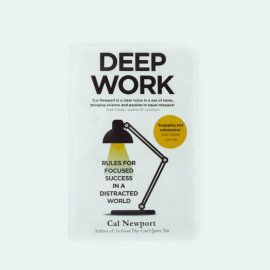

This article is an excerpt from the Shortform book guide to "The Four Steps to the Epiphany" by Steve Blank. Shortform has the world's best summaries and analyses of books you should be reading.
Like this article? Sign up for a free trial here.
What makes some startups succeed while others fail in today’s competitive market? How can entrepreneurs validate their business ideas before investing significant time and resources?
The Four Steps to the Epiphany, a book by Steve Blank, presents a systematic approach to building successful startups through customer development. It helps entrepreneurs understand their market, validate their ideas, and achieve growth by focusing on customer needs before product development.
Keep reading for an overview of this book that could transform your entrepreneurial vision into a thriving business.
The Four Steps to the Epiphany Book Overview
The Four Steps to the Epiphany, a book by Steve Blank, tackles one of the most daunting challenges that new businesses face—the uncertainty of whether there’s a genuine market demand for their product. Blank writes that the key to identifying customer interest is understanding needs and behaviors through a process called customer development: a rigorous and systematic model that startups can follow to validate their business ideas, ensure product-market fit, and ultimately achieve scalable growth. This framework mitigates the high uncertainty and risks involved in entrepreneurial ventures.
Blank is an entrepreneur and educator with decades of experience creating and scaling successful startups. His expertise is grounded in both personal entrepreneurial ventures and his role as an advisor and lecturer at institutions like Stanford University and UC Berkeley. His advice is particularly valuable for early-stage entrepreneurs, investors, and educators who seek a structured approach to navigating the complexities of launching a new venture. The Four Steps to the Epiphany was originally published in 2003; our guide is based on the updated edition published in 2013.
In our overview, we’ll explore how the customer development process differs from product development, the four market types your startup may enter, and how to define your goals and mission. We’ll then explain Blank’s four-step process of customer development, which includes 1) finding your customer base, 2) testing your business model, 3) acquiring customers, and 4) establishing and growing your company.
The Importance of Customer Development
Blank explains that most startups launch using a product development process, through which they focus primarily on refining their offering. This process consists of four steps: 1) conceiving of the product, 2) developing the product, 3) testing the product, and 4) launching the product. This model is an effective way to launch a new product when a company already knows its market, competition, and customer base. It’s therefore used—often successfully—by large, established companies.
Startups, however, can’t rely on the same process as large businesses because the process assumes a level of market knowledge and certainty that most new ventures don’t have. Therefore, Blank recommends that startups complement their product development process with a customer development process. Like product development, it boils down to four steps: 1) finding your customer base, 2) verifying your customer base, 3) acquiring customers, and 4) establishing and scaling your business. Unlike product development, it focuses first on customer characteristics and needs rather than on product features.
Blank writes that product development and customer development should occur simultaneously, but the customer development process should shape a startup’s business model.
Whereas product development focuses on launching a product, customer development prioritizes understanding customers and their needs from the very beginning. Blank emphasizes that customer development isn’t simply a sales or marketing process but a distinct set of activities aimed at proving market existence, verifying customer willingness to pay, and creating the market itself. It’s a process of learning about your customers and their problems, which Blank argues should occur as early in the startup process as possible.
Pitfalls of Product Development Without Customer Development
Blank highlights some of the ways in which relying exclusively on product development (without customer development) can lead startups to fail.
Pitfall #1: Focusing Too Much on the End Goal
Blank explains that product development focuses on creating, launching, and shipping the product. This focus fails to account for the huge amount of work that needs to be done before you can reach these end stages—namely, learning about and building your customer base. No matter how great your product is, your company won’t succeed if you don’t have customers.
Pitfall #2: Different Milestones and Lack of Pacing
Product development and customer development also progress according to different milestones, which means they require different pacing. Blank warns that if you adhere to the milestones of product development while skipping the milestones of customer development, you risk setting an improper pace for your company. This might lead to, for example, hiring and expanding too quickly based on optimistic projections of customer interest that fail to materialize.
According to Blank, the product development process is linear and follows a predictable pattern with easy-to-measure objectives. For example, you know you’ve hit your stage 2 milestone when you’ve created a product that works—a clear-cut and understandable metric.
In contrast, says Blank, customer development has more subjective, nebulous milestones. It’s much more difficult to determine that you fully understand your customers than it is to ascertain whether a product works on a basic level. To measure progress using the customer development model, startups thus must use qualitative, rather than quantitative, metrics. For example, instead of sales numbers, they might measure progress by answering questions like, “do we understand our customers’ problems?” or “do we know which desires our customers value most?”
Pitfall #3: Lack of Customer Feedback in Marketing
The product development process also lacks a means of collecting feedback from customers to inform marketing practices, explains Blank. Marketing begins early on in product development to ensure there’s a demand. This includes activities such as creating sales materials and hiring public relations staff. However, since sales haven’t yet begun at this point, companies aren’t able to garner and incorporate feedback from real customers. This can lead to wasted resources and marketing campaigns that fail to resonate with the target market.
Preparing for Customer Development
So far, we’ve explained why startups should implement customer development alongside product development. Next, we’ll describe the key steps to laying the foundation for customer development: First, familiarize yourself with the four market types and which one your startup falls under. Then, establish your mission statement and core values. Finally, ensure that everyone involved in your startup is on the same page and ready to take on the customer development process with shared goals in mind.
Understand the Four Market Types
Blank outlines four types of startup markets: 1) new market, 2) existing market with a new product, 3) resegmented market with a cheaper product, and 4) resegmented market with a more specialized product. Each market type requires different strategies to succeed, so your market type will determine many of the decisions you make throughout the customer development process.
Market Type #1: New Market
When your product provides an original function that no other current product provides, you’re creating a new market. Blank explains that the benefit of creating a new market is that you have no competitors. The challenge is educating potential customers about a product or service they’ve never encountered before. The market size is unknown, and there may be no direct competitors, but the startup must carefully manage its finances during the potentially lengthy adoption phase.
Market Type #2: Existing Market With a Better Product
Startups that are introducing a better product into an existing market are trying to supplant other companies from their control over the market. According to Blank, an advantage of entering an existing market is that you already know the market size and the competitors, which can simplify some aspects of the business strategy. However, the challenge lies in differentiating the product from competitors and capturing market share.
Market Type #3: Resegmented Market With a Cheaper Product
Startups that are introducing a cheaper product into an existing market are targeting a specific subset of customers in that market (or resegmenting it), explains Blank. They’re aiming to capture those customers who want a more affordable version of the product that will satisfy their needs—even if it’s not quite as high-quality as the more expensive alternative. This approach can be effective because established companies often ignore these more price-sensitive customers to focus on higher-end offerings. The challenge is convincing your customers that your product is good enough to serve their needs, and establishing a business plan that has a low buy-in and the potential for long-term sustainability.
Market Type #4: Resegmented Market With a Specialized Product
According to Blank, startups that are introducing a specialized product into an existing market are attempting to convince customers that their product is more specialized to those customers’ specific needs. If done well, this strategy can allow a startup to become a—or even the—leading player in that market. The challenge is that established businesses will aggressively oppose this threat to their lucrative place in the current market.
Blank explains that most startups fall into the latter two categories of resegmenting an existing market with either a cheaper or specialized product.
Establish Mission Statement and Core Values
In addition to understanding your market type, Blank recommends that you create and display a clear mission statement and core values to guide the company during times of uncertainty or turmoil.
Your mission statement is a general description of your product concept as well as the market type you’re entering. It should be concise—no more than two paragraphs—and clear, as it will help keep your team oriented toward your shared goal. The mission statement may change gradually over time, but it shouldn’t waffle frequently based on each new trend in the market.
Your core values, on the other hand, should remain constant, serving as the ethical and moral foundation of the company. He advises limiting the number of core values to between three and five to be most effective. For example, a talent agency’s core value might be, “We believe in uplifting the great artists of our time.”
Get Everyone on the Same Page
No matter how well you’ve thought out your business plan, you won’t be able to execute it without the help of your whole team. Blank emphasizes how important it is to secure commitment from all stakeholders before embarking on the customer development journey. This means educating executives, board members, and other important players about the customer development process and how it differs from traditional product development. Remember that customer development isn’t replacing product development; rather, you’ll use both in tandem to accomplish your goals. Everyone in a startup needs to understand this and be ready to synchronize these processes.
The Four Steps of Customer Development
Now that you’ve learned the importance of customer development; ascertained your market type, mission statement, and core values; and organized your team around your shared goals, you can begin the four-step process of customer development. These steps boil down to 1) finding your customer base, 2) verifying your customer base, 3) acquiring customers, and 4) establishing and then growing your business.
Step #1: Find Your Customer Base
As you set out to learn about your market and what direction your company should take, you’ll have to make some assumptions about your customers and how they’ll react to your product. It’s important to clearly identify these assumptions so you can gauge your progress and adjust accordingly throughout the process. Thus, the first stage in finding your customer base is to identify your assumptions.
Identify Your Assumptions
Blank explains that you’ll have to make assumptions about your product itself (benefits and features, release date, and so on), customers (types of customers, what problems you’ll solve for them), pricing, how you’ll create demand for your product, your market type, and how you’ll square up against your competitors. Write a one- to two-page document for each assumption.
For example, you might assume that your product will mostly appeal to teenagers—an assumption about the type of customers you’ll be serving.
Test Your Assumptions and Make Appropriate Changes
According to Blank, your initial assumptions likely won’t stand up to scrutiny once you start gathering customer input. Reach out to your potential customers to get feedback on your ideas, and determine whether you’ve accurately guessed what their problems are. If you find they have problems you failed to guess or that the things you identified aren’t actually problems for them, do not try to convince them otherwise. Use the information to modify your assumptions about what they need. You should also test your assumptions about the market and your competition—meet with people from other companies in the same field, and examine existing data from analysts about your potential market.
Share the results of this stage with your entire team, and modify your assumptions documents accordingly. This may mean you need to make a hard pivot—you might need to make drastic changes to your product, shift your focus to a different type of customer, or switch to a different market type. After you’ve modified your assumptions document, seek out customer feedback again and repeat the process until your assumptions align with a profitable business model. This means you must have 1) identified a substantial problem customers face, 2) conceived of a product that will solve that problem, and 3) devised a clear plan for production and distribution that will provide sufficient revenue to outweigh costs and turn a profit.
Continuing the example, if you’ve assumed your main customers will be teenagers, but then during the testing stage you find a greater interest in your product among older adults, you’ll share that information with your team and change your assumptions document to reflect this new knowledge. Then you’ll continue to test and refine until you’re confident you have a solid business plan.
Step #2: Testing Your Business Model With Your Customer Base
After you’ve found your customer base, it’s time to test your business and sales model to see if it resonates with that base. Blank explains that companies often jump the gun and hire large sales staff at this stage despite not yet having a solid sales model. This stage is not about selling: Rather, it’s about developing a sales plan that will be successful once you finish customer development and begin selling in earnest.
Blank advises that for this step, you’ll develop your sales materials and plan, and then test it out by attempting to sell your (currently unfinished) product to early adopters. These are people at high levels of a company who have decision-making power and are willing to take a risk on the product you’re promising them. You only need a few of these to test your sales on; this step isn’t about generating an immediate profit, but about making sure you can sell the product.
Blank explains that this is also the stage where you need to decide how you want to shape public perception of your product and your company—a practice known as positioning. Based on what you’ve learned in step 1 and from your preliminary sales to early adopters, decide how you want the public to view your product in comparison to competitors. The way you do this will depend in part on your market type.
Positioning by Market Type
There are four startup market types: 1) new market, 2) existing market with a new product, 3) resegmented market with a cheaper product, and 4) resegmented market with a specialized product. Depending on your market type, you can determine how to shape public perception of your product. However, it’s not until Step 3 that you’ll begin implementing your positioning strategy.
Blank writes that when positioning your product in a new market, you need to explain what purpose your product serves on a basic level: What issue is it going to help your customer with, and how?
For the other three market types, your customers will already understand the purpose of the product, so the goal is to demonstrate how it’s superior to competing products.
- For a new product in an existing market, clearly delineate how your product is better than competitors.
- For a resegmented market with a cheaper product, explain how the lower cost will provide the customer with a greater value.
- And for a resegmented market with a specialized product, explain the unique value your product offers your customers that existing products don’t.
Assess Next Steps
Before moving on to Step 3, confirm that you’ve accomplished what you need to in Step 2. If you’ve identified flaws in your sales plan, failed to come up with a sales model that you can repeat and expand, failed to identify how you want the public to perceive your product, or noticed any other issues in your plan, don’t move on to the next step. Instead, repeat Step 2 again, or even return to Step 1.
Step #3: Acquire Customers
Once you’ve found your customer base and tested your business model, it’s time to make a plan for acquiring customers, explains Blank. This is when you’ll apply all the information you’ve gathered so far and actually introduce your product and your company to the market. This step includes four essential elements: establishing your objectives for the first year of your business, implementing your positioning strategy, launching your product, and generating demand for your product.
Setting Objectives for Year One
At this stage, writes Blank, set your goals for the upcoming year. This includes how much money you intend to make, how much you intend to spend, and how much of the market you intend to capture.
According to Blank, your market type will determine your year-one goal for how you’ll capture the market:
- For a new market, you’ll need to build the market from scratch, educating customers about it and relying on early adopters to spread the word about it.
- For a new product in an existing market, your goal should be to capture as much of the market from existing competitors as you can.
- For resegmenting a market, you have to not only capture as much as you can from existing competitors, but also spread the word to customers about the new value you’re introducing into the market.
Implementing Positioning Strategy
Next you’ll need to begin implementing the positioning strategy you identified in step 2, explains Blank. He recommends that you hire a public relations team to put this into action.
Blank says to make sure you hire people who are on board with your work so far, including your market type and positioning strategy. They’ll gather data from outside the company about how your product is viewed. At the same time, you should gather the same data from within your company to make sure everyone is still on the same page and to elicit new ideas that could help you going forward.
Launching Your Product
Next, Blank explains how you’ll launch your product and your company. He emphasizes that this stage is the culmination of all previous strategic efforts and should be approached with careful planning and consideration.
Here again, your market type will determine the type of launch you should use.
For a new market, your launch will be a long process that relies heavily on your early adopters. The goal is to educate and engage early adopters, leveraging their excitement to inject your new concept into public awareness, which is how you create a new market.
For an existing market, Blank recommends a much more direct approach in which you hit the market with your product in conjunction with aggressive marketing and advertising. This is a much faster process than his recommended method for a new market, but it also has heavy costs at the front end.
For resegmenting a market, Blank explains that you’ll have to make more nuanced decisions about your launch process. How you proceed will depend on whether there’s an existing customer base poised to buy your product. If there is, you can use the same aggressive strategy as you would entering an existing market with a new product. However, if you have to create this customer base, you’ll need the slower, early-adopter-centered approach he recommends for a new market.
Generating Demand
To generate demand, Blank writes, you first need to ensure that your strategy aligns with your first-year goals. Then you’ll implement this strategy depending on your market type.
- For a new market, you’ll bring customers over to your market by communicating to them what your original product can offer.
- For an existing market, you’ll find current customers in the market and direct them into your new share of the market.
- For resegmenting a market, you’ll combine these two strategies, communicating to customers what you can offer them while also pushing existing customers into your share of the market.
Finally, at the end of Step 3, consider your progress and determine whether you’re ready to move on from this step. If you find that customers aren’t responding to your messaging, your product isn’t positioned as you intended, or your strategies haven’t generated enough demand, repeat the earlier parts of Step 3 until you get the results you want. However, if everything is going according to plan, you can move on to the final step in customer development.
Step #4: Establish and Grow Your Business
Once you’ve found your customer base, tested your business model, and effectively acquired customers, you can focus on the last stage of customer development: establishing and growing your business.
Blank identifies three key actions necessary for a startup to successfully transition into a larger company. First, the company must expand its customer base from the early adopters to the broader market. This shift requires a different approach to sales and marketing, as well as the ability to scale operations to meet increased demand. For example, a company that has appealed to their early adopters through business-to-business referrals might switch to viral marketing to reach mainstream customers.
Second, Blank explains that the organization needs to develop its structure and executive operations to support growth. Implement processes and procedures that allow for efficient operation at a larger scale, while still maintaining the flexibility and innovation that characterize successful startups. It’s a delicate balance between establishing necessary structure and avoiding stifling bureaucracy.
Third, says Blank, the company must create departments that can respond quickly to changes in the market and customer needs. These units help maintain the mindset of information-gathering that drove the company’s initial success. They allow the organization to stay responsive to external factors such as competition, evolving customer preferences, and market trends.

———End of Preview———
Like what you just read? Read the rest of the world's best book summary and analysis of Steve Blank's "The Four Steps to the Epiphany" at Shortform.
Here's what you'll find in our full The Four Steps to the Epiphany summary:
- The four different types of startup markets
- How to identify customer interest in your product
- The three key actions necessary for a startup to grow






